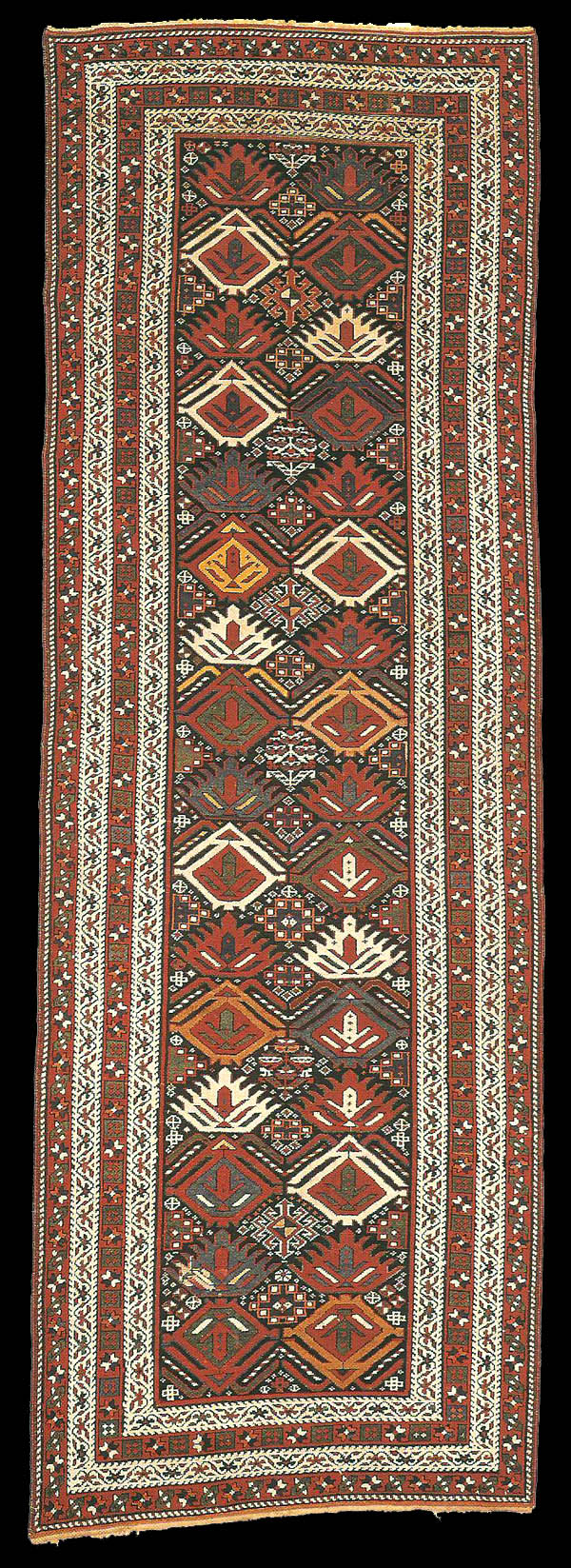|
57 Erfi Konakhkend
district,
321 X 109 cm
End of the 19th century
The dark-blue
central field consists of two vertical rows of palmette-like motifs in two
variations alternating from one row to the next. Hook-rimmed lozenges and
bushes appear between them in staggered rows. L. Kerimov reports that the
main ornaments are called chadyr (tent) and the bushes kyol (pel).
The border system of four stripes consists of two alternating patterns. The
white-ground border presents a vine meander with blossoms, the red-ground
border an ulduzlu zanjireh (star chain). According to L. Kerimov, such
carpets are seldom found with a width of more than one meter.
Warp: Wool, Z3S,
ivory.
Weft: Cotton+ Wool. Z3, Cotton, Z 2-3, white and ivory, 3 waved wefts.
Pile: Wool, Z2; Camel Hair, Z2, Pile Height: 4mm. Knots: Symmetrical 1, \, H
35, V32 = 1,120 Kn/dm2. Handle: Soft, thin, extremely flat-grained. Upper
End: c. 1.7cm wool flat-woven end, c. 1 cm soumak in six rows: 1 light red,
otherwise brownish-red, then light, extremely fine wool simple tapestry
weave. Lower End: c. 2 cm wool flat- woven end, like upper end, but broader
simple tapestry weave, plain soumak except for the 5rh row.
Selvedge: c. 0.8 cm brownish-red wool shirazi around 2 ribs in
figure-of-eight wrapping with supplemental threads which frequently extend
into the fabric.
Colours: 9: brownish-red, brownish-orange, yellow, brown (camel hair),
blackish-brown (oxidised), dark blue, blue, dark turquoise, ivory.
Condition: On the whole, somewhat short, otherwise complete.
Remarks: I (Siyawoush Azadi) have considerable doubts about the
classification "Southern Kuba". This piece - which in reality appears much
lighter than Kurdish workmanship - is more likely from the Karabakh region.
The carpet strongly resembles Shahsevan pieces from the Veramin region.
Literature: L
Kerimov II, colour ill. 27; James D. Burns pictured the earliest piece known
to me in The Caucasus Traditions in Weaving, Seattle 1987, plate 11. That
carpet is introduced as Karabakh.
 |

